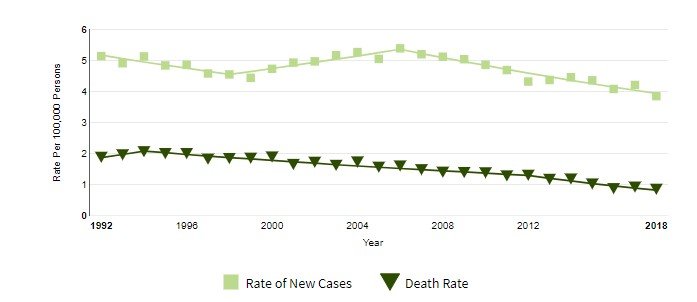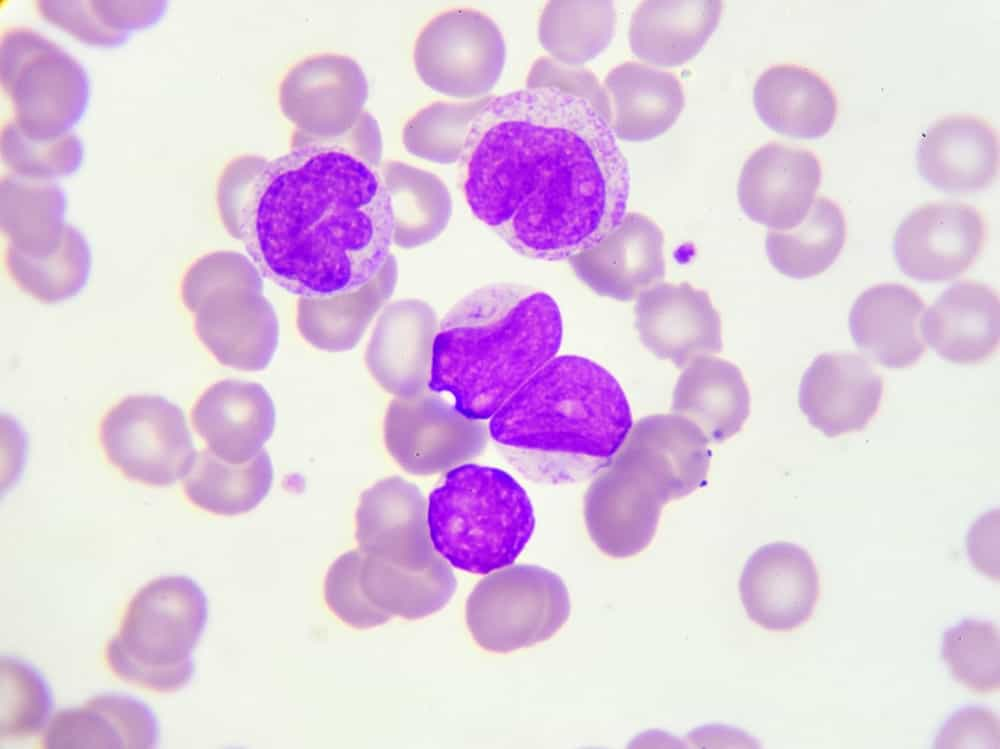Small lymphocytic lymphoma (SLL) is a cancer of the immune system that affects the white blood cells that fight infection, called B cells. SLL is a type of non-Hodgkin’s lymphoma, as is chronic lymphocytic leukemia (CLL). Both cancers are basically the same disease, and are treated in almost the same way. The difference between the two types of cancer concerns the part of the body where it is located: in SLL, cancer cells are mainly in the lymph nodes and spleen, while in CLL, most of the cancer cells are in the blood and bone marrow.
Considered “indolent,” i.e., slow-growing, diseases, SLL/CLLs are usually not curable with standard treatments, and many patients can survive for a long time, living with these diseases for up to several decades. Over the years, but not always, these can evolve, transforming the initial type of lymphoma into a more aggressive one.
Based on updated statistics through 2018 (over the previous four years), the rate of new CLL/SLL cases per 100,000 individuals was 4.6 per 100,000 men and women per year, trending slightly downward over the past 40 years. In contrast, the lethality rate was 0.9 per 100,000 men and women per year, also on a steeper downward trend.

Statistics
Again based on data from 2011-2017, the survival after 5 years of a patient with CLL/SLL is approximately 86.9% of cases (excluding the risk of death due to other cases). Obviously, these are statistics that cannot be used for an exact prediction on an individual patient. Analyzing the demographic base of new patients by age group, it is evident that the 65-74 year old group, with almost one third of cases (31.1%), is the most at risk of contracting the disease, followed by the 55-64 year old group (24.8%) and the 75-84 year old group (21%), for an overall average age of cica 68 years.
What causes SLL/CLL?
It is not exactly clear what is able to cause SLL and CLL. Lymphoma sometimes runs in families, although science has not identified a single gene responsible, so if a family member has SLL, your risk of getting this type of cancer is low overall.
There is weak evidence of slightly higher risk cases of SLL / CLL in individuals who have worked on a farm or as a hairdresser. Sun exposure may reduce your risk, but the sun’s UV radiation is linked to other health problems, such as skin cancer.
How to diagnose SLL/CLL?
Doctors diagnose SLL/CLL by performing a biopsy of an enlarged lymph node. You’ll first get local anesthesia to numb the area. If the enlarged node is deep in your chest or belly, you may get general anesthesia to sleep through the procedure. During a biopsy, your doctor removes part or all of the affected lymph node. The sample is then sent to a laboratory for testing.
Other tests used to diagnose a Small Lymphocytic Lymphoma include:
- a physical exam to check for enlarged lymph nodes or a swollen spleen
- blood tests
- Imaging tests such as an X-ray or CT scan
Want to learn more about diagnosing Small Lymphocytic Lymphoma (SLL)?
Click on our Search Tab to learn about the best recommended methods to diagnose Small Lymphocytic Lymphoma (SLL)
You may also like
Hearing loss: things to know before buying a hearing aid
Choosing a hearing aid isn’t easy, especially if you’ve never used one. They come in different shapes, colors and levels of technology.The first factor in determining which hearing aid to choose is your hearing loss, which could range from very mild to severe. Next, you need to know what you would like it to be… Continua a leggere Hearing loss: things to know before buying a hearing aid
Small Lymphocytic Lymphoma (SLL): Symptoms and Treatments, Causes and Diagnosis
Small lymphocytic lymphoma (SLL) is a cancer of the immune system. It affects infection-fighting white blood cells called B cells. SLL is a type of non-Hodgkin’s lymphoma, which along with chronic lymphocytic leukemia (CLL) indicates the same type of disease, treated the same way. Whereas in SLL, the cancer cells reside primarily in the lymph… Continua a leggere Small Lymphocytic Lymphoma (SLL): Symptoms and Treatments, Causes and Diagnosis
Diabetes Type 2: Epidemiology and Prevention
Diabetes Epidemiology Diabetes is a very common disease. New updated data from the new International Diabetes Federation (IDF) Diabetes Atlas show that more than 34 million Americans have diabetes (1 in 10 individuals), of whom approximately 90-95% have type 2 diabetes. In UK the situation is slightly better: with nearly 4 million sufferers, about one… Continua a leggere Diabetes Type 2: Epidemiology and Prevention
Diabetes: Diagnosis and Types
Diabetes mellitus is a chronic metabolic disorder that affects our body’s energy processes. Following the daily intake of food, a good portion of the nutrients are broken down into sugars (glucose), which are then transferred to the blood vessels. When the level of sugars (blood glucose) exceeds threshold levels, the pancreas kicks in. It releases… Continua a leggere Diabetes: Diagnosis and Types
